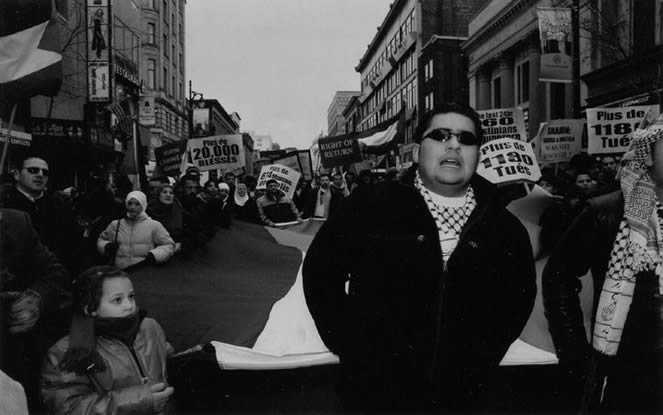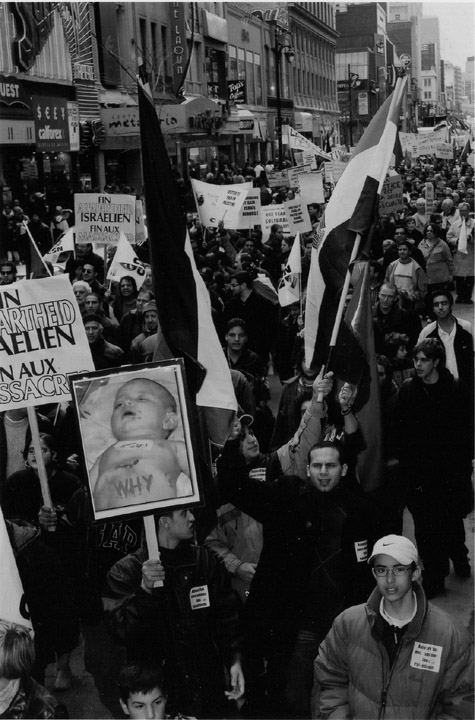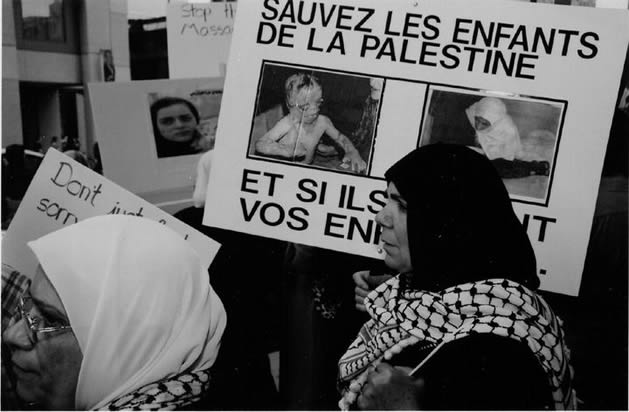
Darren Ell is shooting from the heart to capture images of resistance in Montreal and the Palestine.
I hear your cameras are packed Darren and you’re ready to leave for Israel and the Occupied Territories tomorrow.
Yep. For three weeks
Nervous?
A little I guess. It doesn’t help I’ve got a stomach bug. But I’ve found these water retention pills and I’m hoping they do the trick.
Do you have any contacts when you get there?
Medecins du Monde and Red Crescent.
Your images in this issue show the Montreal part of an international people’s movement in action over the last year. What moved you to photograph it?
After a year of studying conceptual art photography, I was looking for something I personally felt had importance to it, so I picked an issue that not only interested me, but one where international solidarity would be a key to any resolution: the Palestinian-Israeli conflict felt like an obvious choice. I began about a year ago.
 |
I understand that you bonded with some of the Montreal groups sympathetic to the plight of the Palestinians?
I have some connections with MAP (Medical Aid for Palestine) and PAJU (Palestinians and Jews United). I offered to document their events for them. This has turned into a full photographic project documenting the life of an international solidarity community, an exhibition in the making that we may tour in the Occupied Territories in the future.
 |
| March 2002, thousands of Montrealers peacefully protest the violent policies of the Israeli government against the Palistinian people. |
You know Darren I wouldn't have thought a photo of a meeting can speak a thousand words. What were you thinking of at the time?
The image is boring enough out of context but serves to highlight how text is often crucial to documentary photography. The people at the meeting are members of a fact-finding mission heading to the Occupied Territories to bring back reports for the Canadian public. Rezeq Faraj, the president of PAJU and a very dedicated activist for Palestinian rights, is educating the group on the issue of the Israeli bypass roads, a network of highways linking Israeli cities and settlements which in effect surround clusters of Palestinian towns, villages and refugee camps, slicing up their land and destroying their community life. So the meeting is quite important. I shoot these events because they are documents of the nuts and bolts work that will eventually improve things for the Palestinian people. This work draws upon Chomsky’s observation on the nature of historical change: “... Martin Luther King was certainly important, but he was not the civil rights movement. Martin Luther King can appear in the history books because lots of people whose names you will never know, and whose names are all forgotten [...] were working down in the South.” The people in the photograph are the people whose names we may not remember.
 |
August 2002, Woman in Black organize a demo in Montreal to signpost the tragedy befalling Palestinian children as a result of Israeli policy. |
In what ways would you say the dominant images we’re being fed out of the Occupied Territories and Israel effect people over here?
I think the images are more radical than the interpretation that’s given them, which probably explains how people can passively watch the news and not do anything about it. An Israeli missile attack on a beseiged Palestinian town is a ghastly enough thing to see, but virtually impossible to react constructively to without context. The emphasis on suicide bombings is unfortunate and cruel really. Don’t get me wrong, suicide bombing is a horrific thing deserving of condemnation. But the Palestinian people are committing acts of resistance, not of aggression; expelled from their land in 1948 and militarily occupied since 1967. The details of the occupation are awful. If the general public got these details as often as they heard about suicide bombers, things might change. So images are important, but context is just as important.
 |
August 2002, Woman in Black organize a demo in Montreal to signpost the tragedy befalling Palestinian children as a result of Israeli policy. |
How do you intend to make your images useful ?
Aside from strictly descriptive photos for the public, to be able to explain what’s going on, I’ll be focusing on Palestinian people... as people. I’d like to do a series of portraits of adolescent boys and girls and ask them about their plans for the future. What has been lost in the hideous policies of the U.S.-Israeli assault and in the mainstream coverage is simply showing these people as people with a culture, with dreams, with daily rituals as unique and interesting as ours..
And when you get back, what then?
I intend to control most of these images in the sense that they won’t be for consumption by the mainstream media. I’ll do slide shows for the public, maybe create some web work with the images and perhaps do a couple of exhibitions. I hope to return there again in 2003 to do more work. I’ll also be doing some more subjective work, looser less obvious documentary photographs that are more about what I am experiencing as a Canadian in this part of the world.
Give 5 adjectives or less that best describe the main features of your style.
I think more time is needed for clear elements of my style to emerge.
Big question now Darren: Do you have any particular influences, shining stars, people, ideas, values that help train your eye or steady a shaking hand during a shoot?
Politically, I’m pretty well-grounded in the thinking of people like Noam Chomsky and Edward Said. They seem to focus on what matters: how policies affect people, treating people as an end and not an incident, and demanding evidence, not simple assertion, for any argument. Photographically, I like the work of some of the photographers from the Magnum Agency, people like Gilles Perress, Larry Towell and Philip Jones-Griffith. Although I will never have the courage to do what they do, their photography inspires me because it eschews pretentions of objectivity and is used to bring about change in important issues.
Before we end, I have to ask, you know, one friend to another: How can you personally justify putting your wonderful partner Paula, your mum and dad, a slew of siblings etc. etc. through three harrowing weeks of worry?
It probably can’t fully be justified, but we all have to do what we feel compelled to do in life. I’ve been thinking about this type of work for a long time, and all the people you mentioned are very supportive of me even though they don’t fully understand why I would want to do it. I think in the end it’s a good thing to do with one’s time and they recognize this. Maybe my concern about these issues and my understanding of them will have a positive effect on the way they see the world too. There’s a certain ripple effect, isn’t there.
I think there must be and I wish you many ripples. Last question: Is there anyone meeting you at the airport?
No. But of course, Paula will be there at Dorval to welcome me back with open arms and great relief !
That’s if her active imagination hasn’t chewed off both those strong arms way past the elbow. Anyway, best of luck Darren.